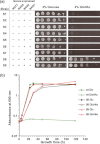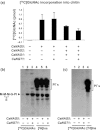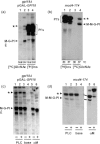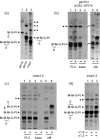Uptake of radiolabeled GlcNAc into Saccharomyces cerevisiae via native hexose transporters and its in vivo incorporation into GPI precursors in cells expressing heterologous GlcNAc kinase
- PMID: 22151002
- PMCID: PMC3498731
- DOI: 10.1111/j.1567-1364.2011.00778.x
Uptake of radiolabeled GlcNAc into Saccharomyces cerevisiae via native hexose transporters and its in vivo incorporation into GPI precursors in cells expressing heterologous GlcNAc kinase
Abstract
Yeast glycan biosynthetic pathways are commonly studied through metabolic incorporation of an exogenous radiolabeled compound into a target glycan. In Saccharomyces cerevisiae glycosylphosphatidylinositol (GPI) biosynthesis, [(3) H]inositol has been widely used to identify intermediates that accumulate in conditional GPI synthesis mutants. However, this approach also labels non-GPI lipid species that overwhelm detection of early GPI intermediates during chromatography. In this study, we show that despite lacking the ability to metabolize N-acetylglucosamine (GlcNAc), S. cerevisiae is capable of importing low levels of extracellular GlcNAc via almost all members of the hexose transporter family. Furthermore, expression of a heterologous GlcNAc kinase gene permits efficient incorporation of exogenous [(14) C]GlcNAc into nascent GPI structures in vivo, dramatically lowering the background signal from non-GPI lipids. Utilizing this new method with several conditional GPI biosynthesis mutants, we observed and characterized novel accumulating lipids that were not previously visible using [(3) H]inositol labeling. Chemical and enzymatic treatments of these lipids indicated that each is a GPI intermediate likely having one to three mannoses and lacking ethanolamine phosphate (Etn-P) side-branches. Our data support a model of yeast GPI synthesis that bifurcates after the addition of the first mannose and that includes a novel branch that produces GPI species lacking Etn-P side-branches.
© 2011 Federation of European Microbiological Societies. Published by Blackwell Publishing Ltd. All rights reserved.
Figures







Similar articles
-
Glycosylphosphatidylinositol biosynthesis defects in Gpi11p- and Gpi13p-deficient yeast suggest a branched pathway and implicate gpi13p in phosphoethanolamine transfer to the third mannose.Mol Biol Cell. 2000 May;11(5):1611-30. doi: 10.1091/mbc.11.5.1611. Mol Biol Cell. 2000. PMID: 10793139 Free PMC article.
-
YLL031c belongs to a novel family of membrane proteins involved in the transfer of ethanolaminephosphate onto the core structure of glycosylphosphatidylinositol anchors in yeast.J Biol Chem. 2000 Aug 11;275(32):24458-65. doi: 10.1074/jbc.M003844200. J Biol Chem. 2000. PMID: 10823837
-
Ngk1 kinase-mediated N-acetylglucosamine metabolism promotes UDP-GlcNAc biosynthesis in Saccharomyces cerevisiae.FEBS Lett. 2024 Jul;598(13):1644-1654. doi: 10.1002/1873-3468.14881. Epub 2024 Apr 15. FEBS Lett. 2024. PMID: 38622055
-
Biosynthesis and processing of the glycosylphosphatidylinositol anchor in mammalian cells.Semin Immunol. 1994 Apr;6(2):73-80. doi: 10.1006/smim.1994.1011. Semin Immunol. 1994. PMID: 8054538 Review.
-
Biosynthesis and function of GPI proteins in the yeast Saccharomyces cerevisiae.Biochim Biophys Acta. 2007 Mar;1771(3):405-20. doi: 10.1016/j.bbalip.2006.05.015. Epub 2006 Jun 3. Biochim Biophys Acta. 2007. PMID: 16859984 Review.
Cited by
-
ATP-Binding Cassette Transporter Regulates N,N'-diacetylchitobiose Transportation and Chitinase Production in Trichoderma asperellum T4.Int J Mol Sci. 2019 May 15;20(10):2412. doi: 10.3390/ijms20102412. Int J Mol Sci. 2019. PMID: 31096671 Free PMC article.
-
The gene YALI0E20207g from Yarrowia lipolytica encodes an N-acetylglucosamine kinase implicated in the regulated expression of the genes from the N-acetylglucosamine assimilatory pathway.PLoS One. 2015 Mar 27;10(3):e0122135. doi: 10.1371/journal.pone.0122135. eCollection 2015. PLoS One. 2015. PMID: 25816199 Free PMC article.
-
Up-regulation of genes involved in N-acetylglucosamine uptake and metabolism suggests a recycling mode of chitin in intraradical mycelium of arbuscular mycorrhizal fungi.Mycorrhiza. 2015 Jul;25(5):411-7. doi: 10.1007/s00572-014-0623-2. Epub 2015 Jan 8. Mycorrhiza. 2015. PMID: 25564438
-
N-acetylglucosamine sensing in the filamentous soil fungus Trichoderma reesei.FEBS J. 2025 Jun;292(12):3072-3090. doi: 10.1111/febs.70015. Epub 2025 Feb 15. FEBS J. 2025. PMID: 39954246 Free PMC article.
-
N-acetylglucosamine (GlcNAc) functions in cell signaling.Scientifica (Cairo). 2012 Jan 1;2012:489208. doi: 10.6064/2012/489208. Epub 2012 Oct 23. Scientifica (Cairo). 2012. PMID: 23350039 Free PMC article.
References
-
- Benachour A, Sipos G, Flury I, et al. Deletion of GPI7, a yeast gene required for addition of a side chain to the glycosylphosphatidylinositol (GPI) core structure, affects GPI protein transport, remodeling, and cell wall integrity. J Biol Chem. 1999;274:15251–15261. - PubMed
-
- Brachmann CB, Davies A, Cost GJ, Caputo E, Li J, Hieter P, Boeke JD. Designer deletion strains derived from Saccharomyces cerevisiae S288C: a useful set of strains and plasmids for PCR-mediated gene disruption and other applications. Yeast. 1998;14:115–132. - PubMed
Publication types
MeSH terms
Substances
LinkOut - more resources
Full Text Sources
Molecular Biology Databases

